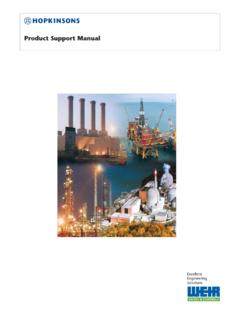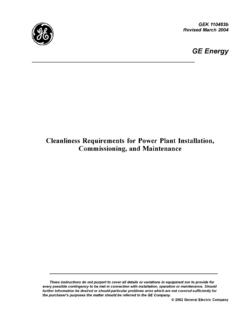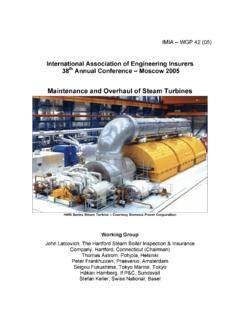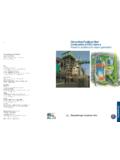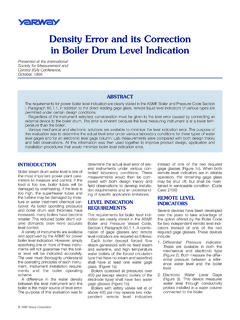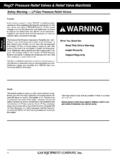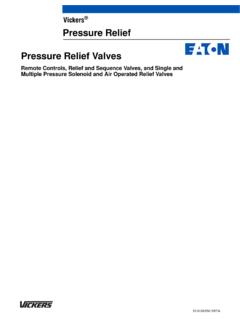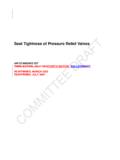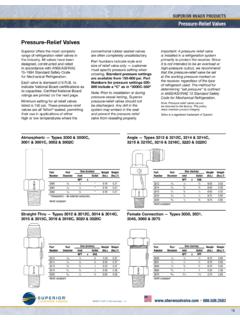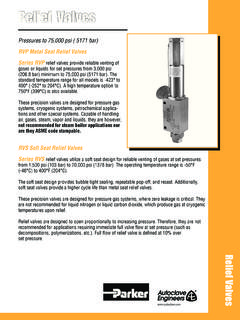Transcription of Selection and Sizing of Pressure Relief Valves - …
1 PDHonline Course M112 (3 PDH)2012 Instructor: Randall W. Whitesides, PEPDH Online | PDH Center5272 Meadow Estates DriveFairfax, VA 22030-6658 Phone & Fax: Approved Continuing Education ProviderSelection and Sizing of Pressure Relief ValvesSELECTION AND Sizing OF Pressure Relief Valves Randall W. Whitesides, function of a Pressure Relief valve is to protect Pressure vessels, piping systems, and other equipmentfrom pressures exceeding their design Pressure by more that a fixed predetermined amount. Thepermissible amount of overpressure is covered by various codes and is a function of the type ofequipment and the conditions causing the is not the purpose of a Pressure Relief valve to control or regulate the Pressure in the vessel or systemthat the valve protects, and it does not take the place of a control or regulating aim of safety systems in processing plants is to prevent damage to equipment, avoid injury topersonnel and to eliminate any risks of compromising the welfare of the community at large and theenvironment.
2 Proper Sizing , Selection , manufacture, assembly, test, installation, and maintenance of apressure Relief valve are critical to obtaining maximum , Design, and ConstructionA Pressure Relief valve must be capable of operating at all times, especially during a period of powerfailure; therefore, the sole source of power for the Pressure Relief valve is the process Pressure Relief valve must open at a predetermined set Pressure , flow a rated capacity at a specifiedoverpressure, and close when the system Pressure has returned to a safe level. Pressure Relief Valves mustbe designed with materials compatible with many process fluids from simple air and water to the mostcorrosive media. They must also be designed to operate in a consistently smooth manner on a variety offluids and fluid phases.
3 These design parameters lead to the wide array of Pressure Relief valve productsavailable in the market : For ease of learning, the student isencouraged to print the glossary and refer tothe definitions of words or phrases as theyfirst appear while studying the 1 - TWO TYPES OR Relief VALVESThe standard design safety Relief valve is spring loaded with an adjusting ring for obtaining the properblowdown and is available with many optional accessories and design features. Refer to Figure 1 forcross-sectional views of typical Valves . The bellows and balanced bellows design isolate the process fluidfrom the bonnet, the spring, the stem, and the stem bushing with a bellows element. Jacketed valvebodies are available for applications requiring steam or heat transfer mediums to maintain viscosity orprevent freezing.
4 Pilot-operated Valves are available with the set Pressure and blowdown control locatedin a separate control pilot. This type of valve uses the line Pressure through the control pilot to the pistonin the main Relief valve and thereby maintains a high degree of tightness, especially as the set Pressure isbeing approached. Another feature of the pilot-operated valve is that it will permit a blowdown as low as2 %. The disadvantage of this type of valve is its vulnerability to contamination from foreign matter in thefluid AND STANDARDSI ntroductionSince Pressure Relief Valves are safety devices, there are many Codes and Standards in place to controltheir design and application. The purpose of this section of the course is to familiarize the student withand provide a brief introduction to some of the Codes and Standards which govern the design and use ofpressure Relief Valves .
5 While this course scope is limited to ASME Section VIII, Division 1, the otherSections of the Code that have specific Pressure Relief valve requirements are listed below. The portionsof the Code that are within the scope of this course are indicated in red:List of Code Sections Pertaining to Pressure Relief ValvesSection IPower BoilersSection III, Division 1 Nuclear Power Plant ComponentsSection IVHeating BoilersSection VIRecommended Rules for the Care and Operation of Heating BoilersSection VIIR ecommended Rules for the Care of Power BoilersSection VIII, Division 1 Pressure VesselsAppendix 11 Capacity Conversions for Safety ValvesAppendix MInstallation and OperationSection VIII, Division 2 Pressure Vessels - Alternative , Chapter II, Part 3 Power Piping - Safety and Relief , Chapter II, Part 6 Power Piping - Pressure Relief PipingASME specifically states in Section VIII, Division 1, paragraph UG-125 (a)
6 All Pressure vessels withinthe scope of this division, irrespective of size or Pressure , shall be provided with Pressure Relief devices inaccordance with the requirements of UG-125 through UG-137. Reference is made to the ASME Boiler and Pressure Vessel Code, Section VIII, Division 1. Theinformation in this course is NOT to be used for the application of overpressure protection to powerboilers and nuclear power plant components that are addressed in the Code in Section I and Section IIIrespectively. The student should understand that the standards listed here are not all inclusive and thatthere exists specific standards for the storage of chlorine, ammonia, compressed gas cylinders, and theoperation of refrigeration units, among probable Brief History of the ASME CodeMany states began to enact rules and regulations regarding the construction of steam boilers and pressurevessels following several catastrophic accidents that occurred at the turn of the twentieth century thatresulted in large loss of life.
7 By 1911 it was apparent to manufacturers and users of boilers and pressurevessels that the lack of uniformity in these regulations between states made it difficult to construct vesselsfor interstate commerce. A group of these interested parties appealed to the Council of the AmericanSociety of Mechanical Engineers to assist in the formulation of standard specifications for steam boilersand Pressure vessels. (The American Society of Mechanical Engineers was organized in 1880 as aneducational and technical society of Mechanical Engineers). After years of development and publiccomment the first edition of the code, ASME Rules of Construction of Stationary Boilers and forAllowable Working Pressures, was published in 1914 and formally adopted in the spring of 1915. Fromthis simple beginning the code has now evolved into the present eleven section document, with multiplesubdivisions, parts, subsections, and mandatory and non-mandatory ASME Code Symbol Stamp and the letters UV on a Pressure Relief valve indicate that the valve hasbeen manufactured in accordance with a controlled quality assurance program, and that the relievingcapacity has been certified by a designated agency, such as the National Board of Boiler and PressureVessel of the ASME Code by the StatesAs of this writing, all states of the United States, with the exception of South Carolina, have adopted theASME Code as jurisdictional law.
8 The student should consult with local regulatory authorities, stateagencies, to determine any specialized jurisdictional requirements for Pressure Relief Valves that may NOMENCLATUREU nless otherwise noted, all symbols used in this course are defined as follows:A = Valve effective orifice area, in .C = Flow constant determined by the ratio of specific heats, see Table 2 (use C = 315 if k is unknown)G = Specific gravity referred to water = at 70 FK = Coefficient of discharge obtainable from valve manufacture (K = for many nozzle-type Valves )Kb = Correction factor due to back Pressure . This is valve specific; refer to manufacturer s = Correction factor for saturated steam at set pressures > 1,500 psia, see Equation 6Kp = Correction factor for relieving capacity vs.
9 Lift for Relief Valves in liquid service, see Equations 1 & 2 Ksh = Correction factor due to the degree of superheat in steam (Ksh = for saturated steam)Kv = Correction factor for viscosity, see Equations 8 & 9 (use Kv = for all but highly viscous liquids)Kw = Correction factor due to back Pressure for use with balanced bellows valvesM = Molecular weight, see Table 2 for values of some common gasesP1 = Upstream Pressure , psia (set Pressure + overpressure + atmospheric Pressure )!!!!P = Differential Pressure (set Pressure , psig ! back Pressure , psig)Q = Flow, gpmT = Inlet vapor temperature, RRne = Reynolds numbers, W = Flow, lb/hrZ = Compressibility factor (use Z = 1 for ideal gas)"""" = Liquid dynamic (absolute) viscosity, centipoiseSIZING AND SELECTIONI ntroductionPressure Relief Valves must be selected by those who have complete knowledge of the Pressure relievingrequirements of the system to be protected and the environmental conditions particular to that often Pressure Relief valve sizes are determined by merely matching the size of an existing availablevessel nozzle, or the size of an existing pipe line and comprehensive Pressure Relief valve Sizing is a complex multi-step process that should followthe following stepwise approach:1.
10 Each piece of equipment in a process should be evaluated for potential overpressure An appropriate design basis must be established for each vessel. Choosing a design basis requiresassessing alternative scenarios to find the credible worst case The design basis is then used to calculate the required Pressure Relief valve size. If possible, the sizingcalculations should use the most current methodologies incorporating such considerations as twophase flow and reaction heat course addresses Pressure Relief Valves as individual components. Therefore, detailed design aspectspertaining to ancillary piping systems are not covered. These are clearly noted in the course. Thesedesign issues can be addressed by piping analysis using standard accepted engineering principles; theseare not within the scope of this course.
